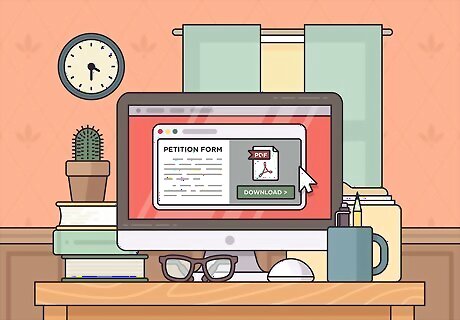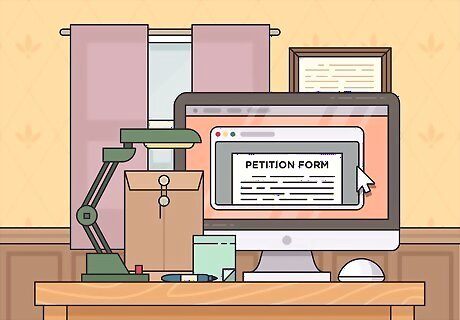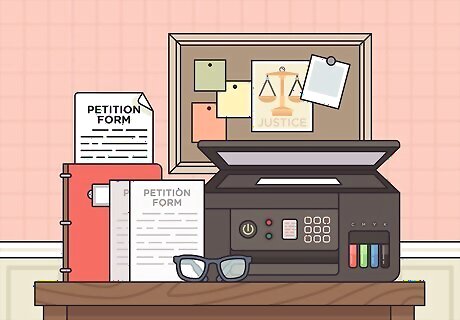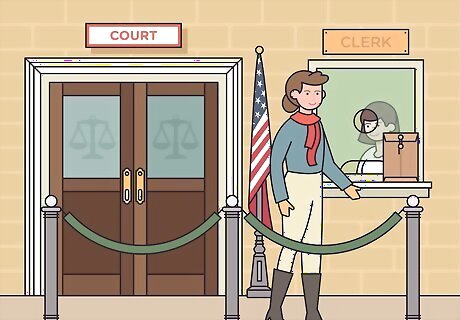
views
Drafting Your Petition

Decide what court you need to use. For most cases, you'll likely use the county court in the county where you live. These are usually courts of "general jurisdiction," which means they can hear cases about nearly any legal dispute. If the respondent lives far away, you may have to file your petition in a court closer to them. Likewise, if your dispute is based on a written contract, the contract itself may specify which court you have to use. Some courts have limited jurisdiction. For example, your county likely has a small-claims court where you can file lawsuits for money. These courts only hear disputes concerning a smaller amount of money — typically only a few thousand dollars at most. They can't hear cases where you want the court to order the respondent to do anything other than pay you money.

Gather information about the dispute you want to bring before the court. Before you can file a petition in court, you need to know who you're suing and what you're suing about. Typically, the person you're suing is whoever is responsible for your issue. It could be an individual person, several people, or a business. If you're suing a business, you need to know that business's correct legal name and the address they use for service. You can find this information in your state's business database, typically on the website for your state's secretary of state. Likewise, if you're suing an individual, you need to know their full legal name and place of residence.

Find the correct form for the type of petition you want to file. Most courts have forms available for many common types of cases. You can typically find these forms on the court's website or by calling the clerk's office of the court where you plan to file your petition. Apart from the court itself, legal aid societies and self-help clinics also typically have forms you can use. If your court happens not to have any forms available, the clerk might be willing to give you copies of some petitions filed in similar cases. You can use those as a guide to set up your format.

Fill out your forms completely. Read through the forms before you start providing information so you can make sure you understand what is being asked in each section of the forms. If you have documents related to your dispute that you need to fill out your forms, make sure you have those close at hand. Typically, you can type your answers on a computer. If you're filling out paper forms, write neatly in blue or black ink. Typically, you can attach related documents to your petition as an exhibit. For example, if you're filing a petition related to a contract, a copy of the contract would be an exhibit to your petition. Provide complete and accurate information for each section of the form. If you don't know something exactly, wait until you find out to continue filling out your forms rather than guessing. The judge expects all of the information in your petition to be correct or you will not get what you're after, even if you prove all other aspects of your case.Tip: Avoid leaving any blanks on your forms. If something doesn't apply to you or your case, write "n/a." If the answer to a question is "none," write that in the blank. Write "self-represented" in any blanks meant for an attorney's name or signature.

Print and sign your forms. Print out forms you've typed up on the computer before signing them. Use a blue or black ink pen for your signature. Write in the date after your signature. If your name is not typed on the form, print it neatly under the signature line. Many courts require you to "verify" your petition if you are representing yourself. This simply means that you have to sign your petition in the presence of a notary. Take a valid, government-issued photo ID with you. The notary will verify your identity before you sign your petition. They will not review the contents of your petition and cannot comment on its legality or offer any legal advice.
Submitting Your Petition to the Court

Make photocopies of your signed forms. Most courts require you to bring at least 2 photocopies of every form you file with the court. One copy is for you and the other copy is for the respondent. If you've named more than one respondent, you'll need a copy for each of them.

Contact the clerk's office before you bring in your petition. When you file your petition, you'll need to pay a filing fee. The amount of this fee varies depending on the type of petition you're filing and the court you're filing it in. Different courts also accept different methods of payment. Individual courts also may have additional forms you need to submit along with your petition, such as a cover sheet. You can usually pick these forms up at the clerk's office and fill them out when you go to file your petition. However, you may also be able to download them from the court's website and fill them out in advance.Tip: While you can typically find most of this information on the court's website, it's still a good idea to call. Policies may have changed without the website being updated.

Take your forms and copies to the clerk's office. Organize your originals and photocopies and carry them in a folder or envelope so they don't get damaged. When you get to the courthouse, you'll have to go through security. If you don't know where the clerk's office is, you can ask one of the security guards. If you don't want to wait, go in the morning just after courts start their morning sessions — typically around 9:30. This is when clerks' offices are typically the least busy. They can get backed up in the afternoon. Some courts have electronic filing systems that allow you to file online. However, if you take the paper documents in person and filing them the old-fashioned way, you can be certain that you've submitted all the correct forms. It's also a good idea to familiarize yourself with the courthouse and the clerk's office since you'll be using them both later.

Pay your filing fee or apply for a waiver. Before the clerk files your petition, they'll ask for payment of your filing fee. Make sure you have the exact amount. The clerk will give you a receipt for your payment, stamp all of your documents "filed," and hand the 2 sets of photocopies back to you. The clerk will also assign a case number to your petition. Write this case number on all documents you file with the court. If you can't afford the filing fee, you can apply for a fee waiver. Typically, a fee waiver will be granted if you have a low income or are currently receiving government benefits. The clerk will give you an application to fill out.Tip: If you're applying for a fee waiver, bring documents with you to prove your income, such as a paystub, and benefit award letters for any government benefits you receive.

Serve the respondent with the petition. The law requires the respondent to have notice that you've filed a petition against them. To provide this notice, you have to deliver the petition to them in a particular way known as "service of process." Typically, you'll get a sheriff's deputy or a private process serving company to take the court documents to the respondent in person. If you've been granted a fee waiver, you typically don't have to pay for a sheriff's deputy to serve the court papers. Otherwise, you'll have to pay an additional fee for service. The fee varies greatly but is typically less than $100. After the documents are served, you'll get a certificate of service from the person who served the documents. Make sure you take this back to the clerk's office and file it if it hasn't already been filed.

Wait for a response from the respondent. From the date the respondent receives your petition, they have a limited time to file a response with the court. The deadline varies among courts but is typically less than 30 days. If the respondent fails to respond, you may be able to ask the court for a default judgment. Even if you're eligible for a default judgment, you may still have to prove some aspects of your case, such as how much money the respondent owes you. The respondent's written answer to your petition will state whether the respondent admits or denies each of the claims you made in your petition, as well as list any possible defenses the respondent thinks might apply to them. If the respondent denies one of your claims, this doesn't necessarily mean that they're claiming it isn't true. Rather, they're forcing you to prove it in court. Similarly, the respondent may list defenses that they actually end up not using in court. Listing them in their answer merely preserves them so that they can use them at the final hearing if they want to.
Engaging in Litigation

Use the discovery process to gain documents and information. Once your petition has been filed and the respondent has filed an answer, you can use legal proceedings to get information about the dispute from the respondent. They can use the same proceedings to get information from you. By the end of this process, both sides will have the same information. Basic discovery methods include: Interrogatories: Written questions about the dispute from the other side. Some courts may limit the number of interrogatories you can ask. These questions must be answered in writing under oath before a specified deadline. Requests for Production: Written requests for the other side to produce documents related to the dispute. Like interrogatories, they may be limited and must be answered before a specified deadline. Depositions: Interviews with the other side of the dispute or with witnesses. These interviews are conducted under oath in the presence of a court reporter who provides a written transcript that you can use as evidence in court.

Read the law that applies to your issue. When you represent yourself, you are expected to know the laws and the rules of the court just as any lawyer would — despite the fact that you're not a lawyer. While you likely won't have time to study the law in detail and memorize all the court rules, you can at least familiarize yourself with the basics. The court's website likely has documents and information that can help you. Legal aid and self-help websites also have resources that can help you better understand court rules. Go to the public law library in the courthouse. Tell the librarian what type of petition you've filed and that you want to read cases that might impact your dispute. The librarian will be able to find some court decisions for you to read.

Go to any hearings scheduled by the judge. If you have a relatively simple dispute, the judge may not schedule very many pre-trial hearings. However, it's likely you'll have at least one. Although these pre-trial hearings tend to be less formal than your trial (or final hearing), you're still expected to follow basic court rules. If you fail to attend a hearing, the judge may hold you in contempt or make a ruling in the respondent's favor. Depending on the reason for the hearing, there's also a possibility that the judge could dismiss your petition. For example, if the respondent files a motion to dismiss your petition and you don't show up for the hearing, the judge may decide to grant the respondent's motion. While often you can refile your petition, that's a lot of extra hassle and expense you could've avoided. If a pre-trial hearing is scheduled that you can't attend, contact the clerk and the respondent as soon as possible to see what you can do to get it rescheduled.

Consult an attorney about the issues in your case. Even if you're committed to representing yourself, an attorney can still offer you some advice on handling your case and point out some problems that may arise. Most civil attorneys provide a free initial consultation. Before you go to an initial consultation, the attorney will likely ask you questions about your case. Write down a list of questions you want to ask the attorney, so you don't forget anything at the meeting. When you go to your meeting, bring all the documents that relate to your case along with your list of questions. If the judge schedules numerous hearings or the litigation before the final hearing gets too complex, you might consider hiring an attorney to help you keep track of everything. In many states, you can hire an attorney who only helps you on specific parts of your case, while you represent yourself in everything else. For example, you could hire an attorney just to conduct discovery. This is called "unbundling" of services.

Attempt mediation if required by the court. Most courts prefer for people to resolve their disputes on their own rather than depending on the judge to do it. With mediation, a neutral third-party works with you and the respondent to find a compromise you can both agree with. Some courts require you to at least try mediation before they'll schedule your final hearing. However, that doesn't mean that you're required to settle your case. You just have to make a good-faith effort. If you can't come to an agreement, the mediator will write a letter for you to file with the court. If you are able to settle your differences through mediation, the mediator will draw up an agreement for each of you to sign. Depending on the subject of your dispute, the judge may also have to sign off on this agreement. For example, if you have a child custody dispute, the judge typically has to approve your agreement and make it an order of the court.
Attending Your Final Hearing

Visit the courtroom before the date of your hearing. If you've never participated in a court hearing before, watching other hearings will help you become more familiar with courtroom procedures and the rules of court you're likely to encounter. Bring a notepad and pen with you to take notes on your observations. Instead of focusing on the case being argued, pay attention to what the people in the courtroom do and how they interact with each other. If any rules are mentioned, write them down so you can look them up later. Observe how others in the courtroom interact with the judge. If the judge ever gets upset about something, take note of what happened.

Bring copies of all documents involved in your case. Organize your documents so you can find what you need without a lot of delay. It helps to make an outline of the case you want to present, then arrange your documents in that order. Make at least 2 photocopies of every document you plan to present to the court so the judge and the respondent will each have a copy to look at.

Arrive at the courthouse at least 30 minutes early. Take account of traffic and give yourself time to park and get through security at the courthouse. Go to the clerk's office and tell them that you're there for your final hearing. When you tell them the name of your case, they'll tell you where your courtroom is. Make sure you don't bring any prohibited items, such as a pocket knife, with you. They will be confiscated at security and you may not get them back. If you have your mobile phone or another electronic device with you, make sure it's turned off or set to silent.Tip: Some courts have specific dress codes. However, generally, you'll be fine if you dress as though you were going to a job interview or a religious service.

Sit in the gallery of the courtroom until your case is called. Typically, the judge is having hearings in several cases on the same day. Take a seat anywhere in the gallery of the courtroom. Once court starts, a court officer will come in and instruct everyone to rise for the judge. The judge may call the cases on the schedule for the day before starting. This allows the judge to see who is ready for their hearing and estimate how long those hearings will take. Typically, they'll take care of the shortest, most straightforward hearings first. When your case is called, stand and say, "Ready, your honor."

Move to the front of the courtroom when your case is called. When the judge is ready to start your hearing, either they or the court officer will call out the name of your case. Stand in place and then move forward to the tables in front of the courtroom. The court officer will help direct you where to go. Once you're at your table, set out your documents so you're ready to present your case.

Present your case to the judge. As the petitioner, the judge will hear from you first. Typically, you will briefly summarize your understanding of the case and what you want the court to do. Then, you can present evidence or call witnesses to support your understanding. Speak slowly and clearly in a loud voice so that the judge can hear and understand you. If the courtroom has microphones, use them whenever you can. This also helps the court reporter. Address your statements only to the judge or to any witnesses you call. Don't talk to the respondent or argue with them, even if they interrupt or try to engage you. If you call any witnesses, the respondent will also be able to ask them questions. This is called "cross-examination." After they've finished, you may have time to ask the witness questions again. This is called "redirect." For example, if the respondent asked something that placed one of your witness's earlier statements in doubt, you could ask your witness questions to re-establish the truth of the earlier statement. The judge may interrupt you at any time to ask you questions. If this happens, stop talking immediately and answer the judge's questions. Do not continue with your previous statements until the judge tells you that you may continue.

Listen to the respondent's arguments. After you've had the opportunity to present your case, the respondent has the same opportunity to tell their side of the story. Like you, they will summarize their arguments, then present evidence or potentially call witnesses to support their statements. If the respondent says anything that you believe is incorrect, write it down. You may have an opportunity to mention this later. Don't interrupt them or call out to them. You will have the opportunity to question any witnesses the respondent calls. Take notes while the respondent is questioning their witnesses if you hear anything you want to press them on further.

Pay attention to the judge's decision. After the judge has heard from both you and the respondent, they will tell you the decision they've made. Take notes so that you get down everything they've said. You may be responsible for writing up the order for the judge to sign — the judge will let you know. Typically, if the judge rules in your favor, it will be up to you to draw up the order. However, some judges have a member of their staff draw up the order instead if you are representing yourself. If the judge rules against you, it may be possible for you to appeal that decision. However, you typically have less than 30 days to do so before the order becomes final. Appeals court rules are far more complex and require an extensive understanding of the law. Talk to an attorney as soon as possible if you think you want to appeal.Tip: Contact the clerk's office to get a copy of the signed order as soon as possible. You will need it to enforce the judge's ruling.













Comments
0 comment